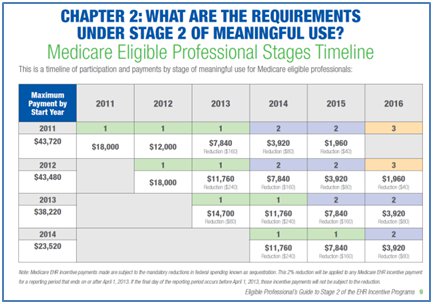The following is a guest blog post by Steve Baker.

With all the talk about Electronic Health Records (EHR) in the medical industry these days, it is easy to be overwhelmed about the complexity. One aspect of EHR is Meaningful Use (MU) and the associated three stages for attesting. MU presents some challenges, but it can also be an opportunity to improve your business and enrich your patient relationships.
Depending on where you are in the process, your challenges may be different from someone else’s. In working with optometrists around the country and listening to a lot of feedback, I see common themes that can apply across all disciplines to help overcome MU challenges. Here are the top three things that you can do to keep moving forward and ultimately turn those challenges into positive opportunities:
- Evaluate your situation
- Develop a plan
- Use a Certified EHR system
Evaluate your situation
Take a look at where you are right now and decide if this is where you want to be. Do you know the requirements for MU Stage 1, 2 and 3? What is your goal to improve office efficiencies and your relationships with your patients? How does MU fit into helping your practice?
Think about the MU objectives as the road map to help you get to where you want to be. For a refresher, MU Stage 1 started in 2011, and Stage 2 starts January 1, 2014. Stage 3 is projected to begin in 2016. For each Stage, there are Core Objectives and Menu “optional” objectives from which to choose. For example, for Stage 1, there were 13 required core objectives and five to choose from the list of 10 menu objectives (total of 18 objectives to achieve). Stage 2 has 17 core objectives and three to choose from the list of 6 menu objectives (total of 20 objectives to achieve).
For those who have not started yet, you can attest for Stage 1 and Stage 2 in 2014. Timeline specifics and associated incentive funds can be seen in this chart published by CMS.

Develop a plan
Do you know your workflow from patient recruiting through exam to retention? Who conducts your office training? What is your goal for patient engagement in the office and outside of it? Have you documented these items? Do you have systems in place to accomplish your goals? If you haven’t done this yet, you’re not alone.
There are many practitioners who have not started yet, so there is a sense of urgency to get going in 2014. In 2012, for example, there were 40,000 optometrists in the United States, according to statistics from the American Optometric Association. A little over 12,000 ODs have attested for Stage 1 MU (HealthData.gov). That’s approximately 30 percent of the optometric space attesting to Stage 1 MU.
When you have a plan, it is easier to implement. Ryan Wineinger, OD, successfully evaluated his practice and developed a plan, and he is now implementing this plan. From Dr. Wineinger’s perspective, “It was critical for me to sit down and look at my practice, decide what I wanted to do and then connect with the right business partner to help me expand my plans and implement them. I’m better able to meet my patient needs now, I’m more streamlined using a cloud-based system, I’m not tied to my desktop computer and I’m ready to start achieving for MU Stage 2 in 2014.”
Use a Certified EHR system
Perhaps you’re still overwhelmed with how to build that plan and implement it. Use a Certified system from a company that will be your business partner. The company will help you to assess what you need based on requirements and your business goals. It will also help you to implement the system that is right for you and provide training and ongoing support to you and your staff. You should be able to efficiently and effectively manage your practice and better serve your patients as a result.
Here’s one example of how you can address a Stage 2 core objective of providing patients with the ability to view, download and transmit their health information. Identify an EHR partner who will help you to create a portal for your patients to go online to access and use their information. It’s imperative that the portal is simple for the patient to look at and use his/her exam and/or lab results and prescriptions. While in the portal, it is also a great opportunity for the patient to send you a secured e-mail or schedule an appointment. The key is to make it easy for the patient to connect with you and the practice in a way that is familiar to the patient. So make sure to account for this in your planning.
Meaningful Use a Challenge?
Yes, it is. But it is also an opportunity to reinvigorate your business, and move it forward. Consult with a practice management business partner to help you be successful. Selecting the right technology and business partner can be the difference between just getting by and moving forward with improving your business and enhancing patient relationships. Keep in mind that this is not a single moment in time but an ongoing process.
Through using up-to-date technology and systems, you can be more streamlined and efficient, and you can positively engage your patients inside and outside of the office. Most importantly, though, you will be positioned for future changes and growth.
Steve Baker is the president of Eyefinity®, a VSPGlobal® company that is the eyecare industry’s premier provider of innovative business solutions serving over 30,000 eyecare professionals with a total solution of integrated technology products and services to help the practitioner increase revenue and enhance patient care. Steve oversees the day-to-day operations of Eyefinity, including business growth, strategic planning, and product development. Steve holds a bachelor of science in computer science from California State University, Northridge, with a concentration in systems design and mathematics. He can be reached by e-mail at Steve.Baker@eyefinity.com.














A certified EHR system with an integrated mobile apps allows the doctors and staff to spend more time working with patients than dealing with the technical aspects of recording data and dealing with the internal EMR infrastructure. Documentation can not only be completed more quickly but also outside the exam room, improving the patient engagement.
[…] Top Three Things that You Can Do to Minimize the Challenges of Meaningful Use […]